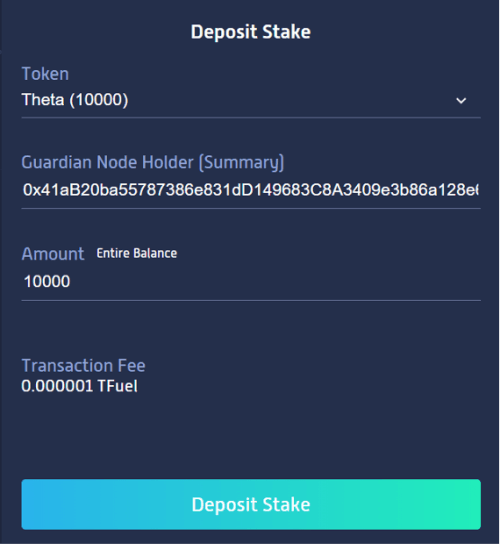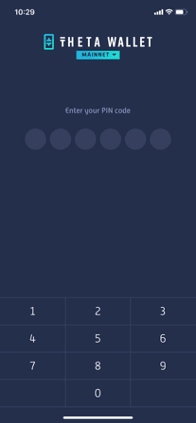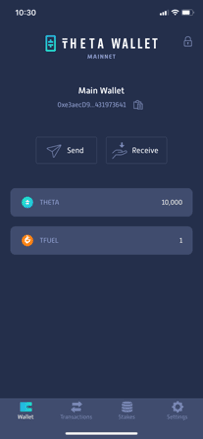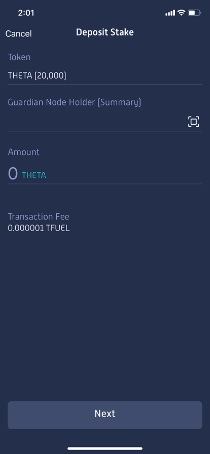{“menuItems”:[{“label”:”What is Theta staking?”,”anchorName”:”https://www.finder.com.au/#what-is-theta-staking”},{“label”:”How to stake Theta”,”anchorName”:”https://www.finder.com.au/#how-to-stake-theta”},{“label”:”Exchanges that sell THETA”,”anchorName”:”https://www.finder.com.au/#exchanges-that-sell-theta”},{“label”:”How much can I earn with Theta staking?”,”anchorName”:”https://www.finder.com.au/#how-much-can-i-earn-with-theta-staking”},{“label”:”Is staking Theta safe?”,”anchorName”:”https://www.finder.com.au/#is-staking-theta-safe”},{“label”:”Pros and cons of staking Tether”,”anchorName”:”https://www.finder.com.au/#pros-and-cons-of-staking-tether”}]}
The Theta network is a blockchain that promises to radically reinvent the back end and delivery of video-streaming services.
It has been created to maximise efficiency and avoid bottlenecks by sharing bandwidth between nodes in a peer-to-peer network. This delivers a more reliable and efficient experience for users worldwide.
There are 2 tokens native to the Theta network: Theta Fuel (TFUEL), which is how participants in the network are rewarded for sharing their computing power, and THETA, which is the governance and staking token.
Note. To stake in the Theta network, you need to hold THETA tokens but will be rewarded in TFUEL.
Users need 1,000 THETA tokens to qualify as a Guardian Node in the network.
Disclaimer: This information should not be interpreted as an endorsement of cryptocurrency or any specific
provider, service or offering. It is not a recommendation to trade.
What is Theta staking?
In the context of Theta, staking is where you are rewarded for allowing some of your computer’s processing power to function as a node in the Theta network. To become a node on the network, holders of the native cryptocurrency token THETA must lock away a certain amount of their token holdings.
Theta employs a multi-layer or multi-BFT proof-of-stake consensus mechanism. Proof-of-stake mechanisms require users to stake tokens to become a “node” and validate the data transferred across the network. With multi-BFT proof of stake, the same process applies; however, there are multiple layers to derive efficiency. For Theta, there is an initial layer composed of 20-30 Enterprise Validator Nodes. These are run by larger organisations and they create new blocks in the blockchain. The second layer is composed of thousands of community-member Guardian Nodes. The Guardian Nodes finalise block creation and secure the network. It is a Guardian Node that users create with their staked THETA.
Staking can be thought of as similar to passive income. After minimal startup action, Guardian Nodes are rewarded in TFUEL for facilitating the update and security of the blockchain. A user is rewarded in proportion to what a user stakes.
How to stake Theta
How to stake via the Theta web wallet
- Go to your Theta web wallet on your desktop browser. Select “Mainnet” from the top drop-down menu (“THETA mainnet (Default)” if it isn’t already selected). If this is your first time using the Theta web wallet, you will need to click “Create Wallet” at the bottom of the screen. Download the encrypted keystore file, which will be used to access the Theta web wallet in the future. Create an accompanying password. Once you have a wallet, unlock your Theta wallet via your preferred secure method.
- On the new dashboard, click on “Stakes”, then “Deposit Stake” and then “Guardian Node”.

- Where it says “Guardian Node Holder” (Summary), enter your identifying data from your Guardian Node app. Add how much THETA you want to stake and then click “Deposit Stake”. Remember, you will need to stake at least 1,000 THETA to qualify as a node and a minimum of 1 TFUEL token for the transaction fee.

- Confirm all the information is correct and then enter your wallet password and click “https://www.finder.com.au/”Confirm & Deposit Stake”. Once the transaction has been completed, you will have become a Guardian Node on the Theta network. You can always refer back to the Guardian Node page to view your staking rewards. Note. If you’re using a Nano Ledger wallet, it’s critical that you go to your Ethereum app and make sure contract data is permitted and that debug data is not displayed.
How to stake via the Theta mobile wallet
- Download the Theta Wallet app to your device and make sure you have the latest version. You can confirm this at the official Theta site.Select “Mainnet: THETA mainnet (Default)” on the dropdown menu. If this is not possible, restart the app.

- After you have unlocked your wallet, go to the “Stakes” tab and click on “Deposit”.

- Go to the “Guardian Node Holder (Summary)” field and use your device’s camera to scan the QR code that you access via your Guardian Node app.Alternatively, if you are working via command line, you can paste the summary directly.

- Enter the amount of THETA you want to stake to your node, and then click “Next”.Remember you will need at least 1,000 THETA to qualify and at least 1 TFUEL token in your wallet to pay the transaction fee.

- And you’re good to go!Once your transaction is confirmed, you can monitor staking rewards and functionality by revisiting the Guardian node tab.
Exchanges that sell THETA
How much can I earn with Theta staking?
As with all staking, how much you earn is directly linked to how much you contribute.
Guardian Nodes on the Theta network earn a proportion of the new TFUEL tokens generated every year. At present, a total of 250 million TFUEL are generated annually. TFUEL tokens are rewarded in proportion to the total of THETA tokens your stake represents.
Let’s look at a simplified example using the 250 million annually generated TFUEL tokens. If you were to stake 500 million THETA and there were a billion THETA tokens in existence, your proportion stake would equate to 50%. You would, therefore, be rewarded with 125 million TFUEL tokens.
We should point out these figures are only to demonstrate the idea and are not realistic.
What does this mean in terms of “real” money?
The market value of your reward depends on the relationship between the current THETA price and the current TFUEL price. This is something we recommend you monitor carefully.
With regards to supply, the total number of THETA tokens is capped at 1 billion. In comparison, TFUEL has an uncapped supply. TFUEL launched in 2019 with 5 billion tokens. The supply is now increasing at a rate of 5% per year.
Is staking Theta safe?
As a result of the reliance on smart contracts and connectivity of the Internet, no digital asset can ever be 100% safe. However, you can cut risks to a minimum with a few simple steps:
- Back up your important files
- Never share your private key with anyone
- Encrypt your main wallet
- Keep a hard copy of your private key in a safe place
- Use a different device for staking to the one you use for everyday activities, especially email.
Pros and cons of staking Tether
Pros
- Innovative. Interesting project with great potential.
- Strong development team. The team is highly professional, energetic and public-facing. YouTube co-founder Steve Chen is an advisor to Theta.
- Tokenomics. The limited supply of THETA tokens and the fact they cannot be earned make them an attractive speculative vehicle, which in turn makes the whole project more attractive.
- TFUEL. The attractiveness of THETA may in the long run maintain the price of TFUEL, which is what you are rewarded with for staking.
- Strong Partnerships. THETA’s partnership with Samsung VR has been a huge boost to its credibility, and more such partnerships could be down the line.
Cons
- High threshold. At current prices, 1,000 THETA tokens is an expensive threshold to cross to qualify for staking. However, the minimum used to be 10,000, so there is nothing to say this won’t change again.
- Weaker returns. Better staking rewards are available elsewhere.
- TFUEL inflation. The 5% annual increase in TFUEL threatens price stability.
- Strong competition. Streaming video is a category dominated by some of the biggest names in technology with significant incumbent advantages.
- Token distribution. The initial ICO drove assets to a small pool of players.
- Low liquidity. Liquidity is on the lower side compared to many other crypto-assets.
- Possibly redundant. Does a solution for cutting bandwidth on video streaming need a cryptocurrency?
Disclaimer: Cryptocurrencies are speculative, complex and involve significant risks – they are highly
volatile and sensitive to secondary activity. Performance is unpredictable and past performance is no guarantee of
future performance. Consider your own circumstances, and obtain your own advice, before relying on this information.
You should also verify the nature of any product or service (including its legal status and relevant regulatory
requirements) and consult the relevant Regulators’ websites before making any decision. Finder, or the author, may
have holdings in the cryptocurrencies discussed.






